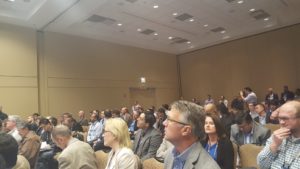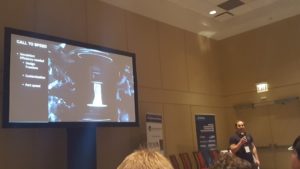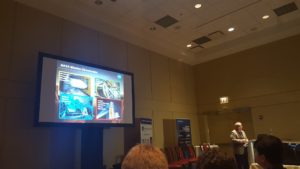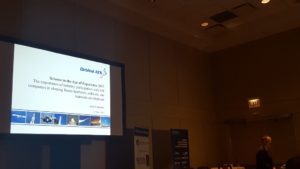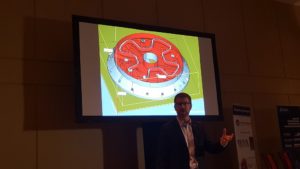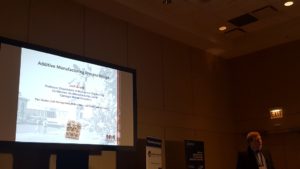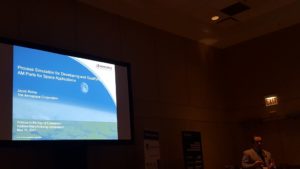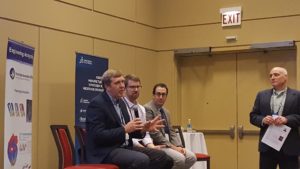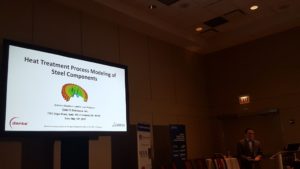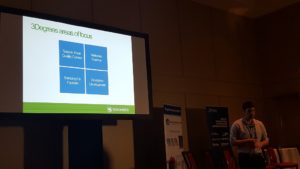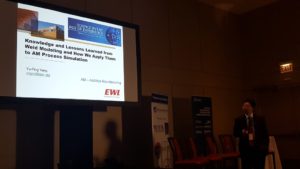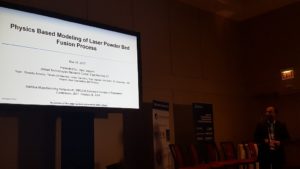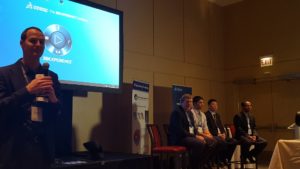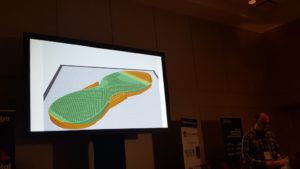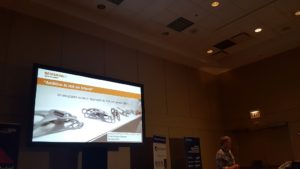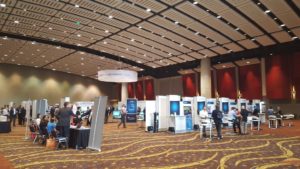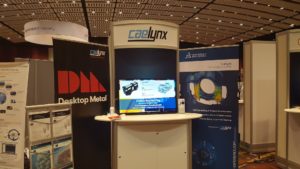Science in the Age of Experience Focuses on Digital Pathway from Concept to Production with Additive Manufacturing Symposium
 This week in Chicago, Dassault Systèmes is hosting Science in the Age of Experience as the company’s 3DEXPERIENCE platform continues with its forward momentum. Dassault, which recently opened its latest 3DEXPERIENCE Center in Wichita, Kansas, is positioning itself as an end-to-end solutions provider and is increasingly showcasing its offerings through high-level and high-profile events. In Wichita, I enjoyed the opportunity to see firsthand the new 3DEXPERIENCE Center and meet the teams behind the technology as well as look at the facilities students and businesses alike will use to push innovations forward; this week I joined almost 200 interested attendees in a day-long Additive Manufacturing Symposium ahead of the official Tuesday start of the more-largely-attended Science in the Age of Experience event held at McCormick Place and the adjoining Hyatt Regency hotel.
This week in Chicago, Dassault Systèmes is hosting Science in the Age of Experience as the company’s 3DEXPERIENCE platform continues with its forward momentum. Dassault, which recently opened its latest 3DEXPERIENCE Center in Wichita, Kansas, is positioning itself as an end-to-end solutions provider and is increasingly showcasing its offerings through high-level and high-profile events. In Wichita, I enjoyed the opportunity to see firsthand the new 3DEXPERIENCE Center and meet the teams behind the technology as well as look at the facilities students and businesses alike will use to push innovations forward; this week I joined almost 200 interested attendees in a day-long Additive Manufacturing Symposium ahead of the official Tuesday start of the more-largely-attended Science in the Age of Experience event held at McCormick Place and the adjoining Hyatt Regency hotel.
When the team initially conceived the idea for the Symposium, they thought perhaps 100 attendees would be interested; 190 registered and filled a room for the day’s interesting and in-depth presentations from a series of well-informed speakers. On the agenda were speakers covering the gamut of 3D printing applications, from shoes moving toward mass production to optimized lattice structures to the challenges inherent in additive manufacturing as industry adapts to new technologies. Seven different sessions spread across the day grouped speakers together for presentations and group Q&As as the room buzzed with idea after idea. Each presentation offered a unique perspective, but common threads emerged throughout the day — most notably of these the focus on the reality of additive manufacturing.
- McCormick Place, this time without a hot air balloon
- The morning crowd at the Additive Manufacturing Symposium
Visionaries retain their place as we look toward futuristic technologies, but as the additive manufacturing industry grows and begins to see some maturation, we’re seeing real-world applications, scenarios, and stories emerge more frequently. We’re leaving the phase of “what if this was possible?” and moving into “what if I brought this technology to this platform?” as working companies adopt new technologies into their workflows. Speakers at the Additive Manufacturing Symposium geared their sessions toward tried and true use cases, including emerging applications, regulations affecting the space, and encompassing end-to-end looks at areas of challenge and of potential that are impacting industry in today’s world.
Symposium sessions and their speakers and moderators included:
- Session 1: Business Transformation: How companies are embracing and adopting additive manufacturing?
- Derek Luther, adidas
- John Vickers, NASA
- Troy Hartwig, Kansas City National Security Campus
- Jerry Feldmiller, Orbital ATK
- Session Chair: Arthur Dubois, Joby Aviation
- Session 2: Design for Additive Manufacturing
- Tim W. Simpson, Penn State University
- Jack Beuth, Carnegie Mellon University
- Jacob Rome, The Aerospace Corporation
- Session Chair: Daniel Fradl, HP
- Session 3: Materials, Standards and Certification
- Lyle Levine, National Institute of Standards and Technology
- Pieter Volgers, DuPont
- Zhichao (Charlie) Li, DANTE Solutions
- Session Chair: Pasquale Carlucci, Picatinny Arsenal
- Session 4: Business Decisions, Cost Analysis, Best Practices for Additive Manufacturing
- Jack Beuth, Carnegie Mellon University
- Mike Vasquez, 3degrees
- Yu-Ping Yang, Edison Welding Institute
- Vijay Jagdale, United Technologies Research Center
- Session Chair: Bill Bihlman, Aerolytics LLC
- Session 5: Functional Generative Design and Topology Optimization
- Bradley Rothenberg, nTopology
- Session 6: Process Simulations
- Session 7: Materials and Compliance
- Arthur Fairfull, Granta Design Limited
From these presentations, I walked away with more than 30 typed pages of notes; the ideas presented throughout six hours of presentation time were often dense. We’ll be breaking some of these down in the near future. To touch on some highlights, I was able to chat with CMU’s Dr. Jack Beuth, who spoke twice during the day (just on the heels of his presentation at last week’s RAPID + TCT event), as well as attend a media briefing in which Dassault executives broke down what they saw as major themes arising throughout the presentations.
We’ve been following Dr. Beuth’s work — including an additive manufacturing course he pioneered at CMU, his picks in what’s hot in metal AM, and his part in conveying to Congress the importance and potential implications of additive manufacturing on the economy — as he has been working intensively with additive manufacturing / 3D printing technologies for some years now and bringing CMU and its NextManufacturing Center into a position of trusted authority. Two major areas of impact for AM in product development are design and simulation — a huge amount of simulation. The best case scenario in product development is to “do as much as possible before prototyping,” Dr. Beuth explained. The capability of AM to produce a prototype within a day is creating a new paradigm that drastically reduces product development times, he noted. As we spoke between his two presentations — “Additive Manufacturing Process Design” in the morning and “Additive Manufacturing Challenges for Industry” in the afternoon — he was gearing up to talk challenges, so we focused there.
“Things are changing very quickly, especially the more we look into it,” he told me. “The theme of the NextManufacturing Center is that the normal thing to do is look at processes as they are now; but this isn’t good, things are changing so fast.”
Dr. Beuth touched on some changes in technologies, noting that new additive manufacturing machines have emerged that are “magnitudes better” than what had been available just two and a half years ago, improving upon build areas and speeds. While newer technologies are still very expensive, they represent big stepping stones — as, he pointed out, do GE’s acquisitions and growing involvement in the additive manufacturing industry.
He continued, “When we look ahead there are challenges for certification. In general, additive manufacturing is just a different way of manufacturing. … There are guidelines for additive manufacturing processes, but it isn’t just one process. There’s a range of processes with some general similarities. People use different powders and alloys; there are so many options and different ways to make money with those options. I’ve never seen anything move as fast as this industry is changing.”
The industry is, obviously, changing at unprecedented speed, and this event underscored the pace of growth through practical use cases from those working in real-world conditions.
 On Tuesday, Sumanth Kumar, Vice President of SIMULIA Growth at Dassault Systèmes, and Subham Sett, Director of Additive Manufacturing & Materials at SIMULIA at Dassault Systèmes, spoke to the press to debrief following the busy Additive Manufacturing Symposium.
On Tuesday, Sumanth Kumar, Vice President of SIMULIA Growth at Dassault Systèmes, and Subham Sett, Director of Additive Manufacturing & Materials at SIMULIA at Dassault Systèmes, spoke to the press to debrief following the busy Additive Manufacturing Symposium.
“What we saw yesterday wasn’t just typical presentations, it was 19-20 customers presenting about their journey,” Kumar said. “This wasn’t about the end product, but about the journey they’re taking, their problems and successes. Automotive to aerospace to defense to consumer goods to life sciences; they were all sharing what’s happening in their industry/company.
What was surprising to me was a few years ago, additive manufacturing was more in the research domain, people thinking of it for prototyping and research. Now companies are moving it into real time production, and seeing the value it is adding to their business. The second key point to emerge was the transformation changes in their own organizations. Not just with or because of 3D printing, but the whole thinking within the company; it’s great to see across the board. The third thing we heard about was taking to market. Yes, there are some differences between industries, but more similarities that I could see.”
A big focus that both Kumar and Sett underscored was the transformative nature of what digital manufacturing and additive processes lend to companies employing them — and how their use necessitates a new way of thinking. This is certainly a recurring theme in the industry as more users and suppliers note that the same thinking will not yield new results, but that we must see an actual shift in thinking to allow for the new capabilities enabled by new technologies.
“A few years ago, yes, there was a lot of hype for additive, you’ve seen that. We were pulled in when hype met reality,” Sett explained. “If you want to produce something, to make something real, you need something real. When we looked at it, we looked at the problem not just from simulation to see how a part performs but also noticed that simulation by itself doesn’t help additive. There is an ecosystem building around this…”
He continued, “We have to fundamentally change how we design our products. It’s been a great journey, and our focus from day one has been industrial additive. We have customers like Airbus getting parts into production, into vehicles where they need to work.”
Kumar came back to the growth of additive manufacturing as adoption will affect business operations, noting:
“You know benefits of additive, that’s been talked about. A side effect I’m seeing is that a designer or engineer is getting familiar about using value of simulation, while an analyst is understanding how to design parts. This is not just a marketing spin, but can be seen in customers like Airbus who have made monumental changes in their organization. Boundaries between various roles are becoming very morphed, as it will change capabilities and job descriptions of people, as a side effect I’m seeing to all this transformation.”
Additive manufacturing is transformative for operations not just in terms of time to market for product development, but for the internal operations of companies using new process solutions. As the customers speaking at this particular event are all utilizing software solutions from Dassault, obviously a lot of the focus remained on these offerings — and the 3DEXPERIENCE platform is indeed expansive, offering a number of applications that customers can (and do) use at every stage of development, from design to simulation to redesign to optimization to production. A nice benefit of an additive manufacturing-focused event being hosted by a software provider is that a larger picture emerges than that sometimes presented when the focus is on hardware capabilities, as a lot has to happen before pressing print on the latest high-tech 3D printer.
Science in the Age of Experience continues this week through Thursday, as a busy agenda offers sessions covering a range of topics as well as the 3DEXPERIENCE Playground showcasing several booths, and a showcase of academic papers. Discuss in the Dassault Systémes forum at 3DPB.com.
Subscribe to Our Email Newsletter
Stay up-to-date on all the latest news from the 3D printing industry and receive information and offers from third party vendors.
You May Also Like
IperionX Inks 10-Year Deal with Wisconsin Manufacturer for 80 Metric Tons of Titanium Per Year
IperionX, the Charlotte-based supplier of sustainable titanium powders used for additive manufacturing (AM) and metal injection molding (MIM), has signed a ten-year deal with United Stars, a group of industrial...
Gastronology Launches Industrial Production of 3D Printed Food for Dysphagia Patients
Food 3D printing has, in many ways, been an additive manufacturing (AM) segment looking for the right business case. While some applications are beautiful and others may or may not...
Lockheed Martin Leads $3M Investment in Q5D’s Electronics 3D Printing System
Q5D, an original equipment manufacturer (OEM) of robotic arm, hybrid additive manufacturing (AM) systems used for wire harness production, has closed a $3 million investment round. The investment arm of...
3D Printing News Briefs, April 6, 2024: Depowdering, Cybertruck Door Handles, & More
In today’s 3D Printing News Briefs, ioTech’s digital manufacturing CLAD technology is opening up opportunities for microelectronics and additive manufacturing. Hexagon and Raytheon Technologies commercially released the Simufact Additive Process...



